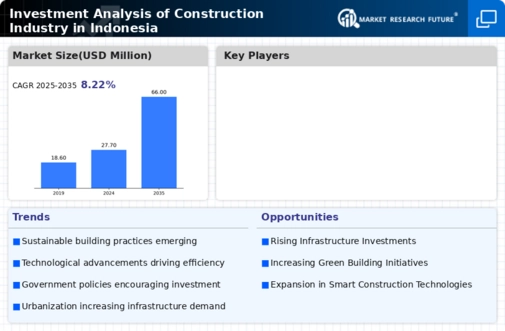Market Analysis
In-depth Analysis of Construction Industry Investment Analysis Industry Landscape
Investors and the construction sector are affected by dynamic trends in the Indonesian construction industry investment analysis. Indonesia's strong economy and infrastructure development provide construction investors a positive outlook. The Indonesian government's infrastructure development efforts drive investment analysis market dynamics. Toll highways, airports, and smart cities have attracted domestic and international investors, improving market dynamics.
Demographic variables also affect Indonesian construction investment analysis. Residential, commercial, and industrial infrastructure is needed due to the country's expanding population and urbanization. Investors looking to capitalize on this demographic transition are constantly monitoring residential real estate, mixed-use developments, and industrial projects, impacting investment analysis market dynamics.
Indonesian construction industry investment dynamics are also affected by government regulations. Government attempts to expedite permit processes, give investment incentives, and improve business conditions attract investors. The construction investment analysis landscape is shaped by investor confidence and regulatory stability.
Indonesia's building industry investment analysis also highlights FDI. The country actively seeks FDI for infrastructure development. Foreign investors provide finance and technical experience, making the building business more competitive. Investment research in the Indonesian construction business requires understanding FDI inflows, regulatory constraints, and government support.
Market trends and construction technology advancements inform investment evaluations by revealing efficiency and cost-effectiveness potential. Investors who prioritize modern construction processes, sustainable practices, and digital technology will likely follow Indonesia's construction sector dynamics.
Investment analysis in Indonesia is also influenced by the construction industry's durability and adaptation to economic changes and global uncertainty. Investors evaluate the industry's ability to handle supply chain interruptions, inflation, and geopolitical factors to make decisions. Comprehensive investment analysis requires understanding the industry's resilience.
Infrastructure financing models like PPPs and project financing affect Indonesia's construction investment analysis market dynamics. Investors examine finance model feasibility and risk to determine building project viability. The government's PPP promotion and financing measures affect investment analysis.
On the supply side, investment analysis relies on local construction businesses' capacity and previous project success. Investors analyze local contractors' credentials, quality, and project efficiency. Partnerships with credible local enterprises are vital to investment decisions.



Leave a Comment